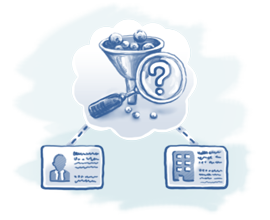The subject of “what constitutes a lead” is often the subject of heated debate between a sales force and a marketing department. Marketing is generating leads and sending them over to sales reps; the sales reps are firing back comments such as, “You call these leads? These guys were barely interested!”
Today astute companies not wishing to simply waste the leads they get—whether super hot or lukewarm—are instituting ways of nurturing leads before sending them onto sales. It is part of an overall lead management system that makes it possible to utilize nearly everything that comes in the door.
 Categorizing Leads
Categorizing Leads
A lead can fall anywhere between “hot” (ready to buy) and “cold” (maybe once interested but has apparently moved on). A company that fully analyzes its sales process places these varying degrees of leads into precise categories indicating their viability. Successful methods of moving them along these categories are found and when they finally arrive at “hot” within your lead management system, they are then and only then forwarded to sales reps to work.
One method of rating degrees of leads relates to prospect behavior. Someone who regularly reads the blog and rarely responds to communication is obviously not as hot as someone who is perusing pricing and prospect specification pages and asking relevant questions.
Inside Sales Team
When new sales reps are hired at a company, it often happens they are made inside reps that work the leads that “aren’t ready for prime time.” But an inside rep should not just be a new person turned loose with a phone and a list to call. If a company (specifically their marketing department) has done their research well, specific methods have been evolved that inside reps utilize to move the leads along from cold to warm to hot.
A good part of what a skilled inside rep is doing is building relationships. By the time a lead is turned over to the sales force, there should be considerable rapport built between the prospect and the company. Remember: you’re not just selling your product or service, you’re selling your company as a source, too.
That relationship building should be also based on research about the prospect and industry. The more the communication is kept relevant, the more of the prospect’s interest you will retain.
Levels of Content
Along with levels of approach utilized by inside sales, there should also be levels of content based on the degree of interest. Someone toward the lower end would probably be more interested in general issues that affect the prospect’s company and the overall industry, and how your product or service fits in. The hotter the lead is, the more product-specific and detailed the subject matter. And remember who you’re talking to: the higher the relevance factor to your specific prospect the more your prospect will read your content.
These levels of content can apply to email blasts, but also to specific landing pages. Some companies even have different editions of their newsletters for prospects and customers; the prospect edition is smaller and more general in scope.
Patterned Through CRM Solution
Your lead management program—nurturing leads along through their various degrees of sellability—is best conducted utilizing a leading-edge CRM solution that exactly follows your sales process. As each lead makes its way along, it is clearly viewable and rated. Sales reps can always see what’s coming, inside sales reps confidently know what to do next and Marketing can exactly and easily target content. Sales management is also able to see where inside sales is weak or strong, and Marketing can also evaluate lead quality.
So within your lead management system, what constitutes a lead? A company that can calmly and accurately answer that question—and have agreement from both sales and marketing on that answer—is well on its way to big-time success if not already there.
What is the best type of CRM solution for your lead management system? Sign up for one of our free webinars and find out.



















